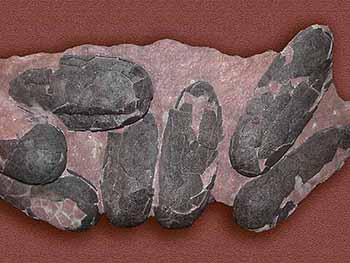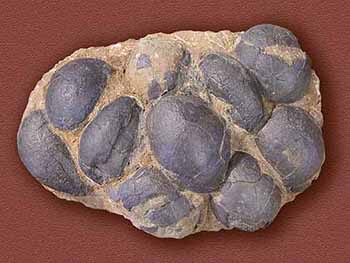Glossary
| Sauropod Dinosaur Eggs |
 |
| Raptor Dinosaur Eggs |
 |
| Dinosaur Eggs |
 |
Dinosaur Eggs
Dinosaurs like most reptiles and birds laid eggs. Although it is possible that some dinosaurs gave birth as mammals do, there is no evidence of this. Over two hundred egg sites have currently been discovered in many countries including: Argentina, France, China, Mongolia, and the United States in the state of Montana. Eggs can come in many shapes and sizes. These include the sphere, prolate spheroid, oblate spheroid, and semiconical. The egg houses the embryo as it develops and provides shelter, food, water, oxygen, and a way of expulsing the waste. Eggs are usually made with soft, flexible, or hard shells. However, in the case of dinosaur eggs, only hard shells have been recovered because these have the biggest chance of becoming fossilized.
History
It has been long assumed that dinosaurs laid eggs as most modern reptiles do. However, these were only assumption until 1859. Jean Jacques Pouech found several egg shells, in France, which were thought to be giant birds. More eggs were discovered in 1869 and assumed to be giant crocodile eggs. These eggs are now known as belonging to the sauropod dinosaur Hypselosaurus. In the 1920's Roy Chapman Andrews led several expeditions into the Gobi Desert and found eggs and nests and several skeletons of ceratopsian Protoceratops. These nests were thought to have been attacked because the skeleton of an Oviraptor, also know as the egg stealer, was found close to the site. This assumption continued until the 1980's when another expedition explored the same site and found one of the nests with an Oviraptor sitting on it. This led to the conclusion that the nests were belonging actually to the Oviraptors. Other discoveries have been made since in Montana and in many other regions.
Identification
Actual identification of the dinosaur to which the egg belongs is very rare. When the egg dies the embryo is usually quickly destroyed. Sometimes small bone fragments are found but are so mixed that it is nearly impossible to identify the species. Usually we know which species it belongs to if the skeleton of a parent is found nearby and this does not always ensure its species. When identification is not known paleontologists compare it with other eggs and give the same type of egg a classification called an oospecies. This does not necessarily imply that the species of the egg is known.
The Egg Shell
The eggshell is classified due to its appearance. This is based on the macrostructure, microstructure, and ultrastructure. The macrostructure is the size, shape, thickness and texture of the surface. The microstructure deals more with the design and structure, including the layout of pore canals. The ultrastructure has more to do with much finer details that include the layout, composition, and structural network.
Bibliography
Dixon, Douglas. The Illustrated Encyclopedia of Dinosaurs. London: Lorenz Books, 2006
Farlow, James; Brett-Surman, M.K. The Complete Dinosaur. Indiana University Press, 1997
Martin, Anthony. Introduction to the Study of Dinosaurs. Malden, Massachusetts: Blackwell Science, 2006